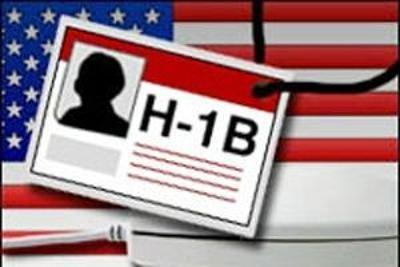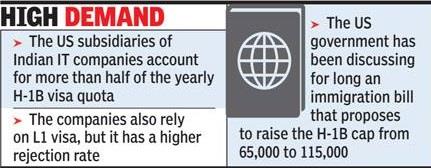March 19, 2014
BANGALORE: The demand for the US H-1B work visas for the coming year is expected to be so high that the quota of 65,000 is expected to be exhausted on the very first day they open for submission – April 1.

The H-1B is a non-immigrant visa that allows US employers to temporarily employ foreign workers.
March 19, 2014
BANGALORE: The demand for the US H-1B work visas for the coming year is expected to be so high that the quota of 65,000 is expected to be exhausted on the very first day they open for submission – April 1.

The H-1B is a non-immigrant visa that allows US employers to temporarily employ foreign workers.
Last year, the cap was reached in five days on April 5, which was substantially faster than that in the years immediately prior to that when demand for IT had slowed following the global recession of 2008-09. Now, with the American economy improving, unemployment rate dropping and IT demand recovering – partly on account of the need to invest in new technologies like cloud, mobility, and analytics – the requirement for foreign technology workers is rising fast.
The H-1B is a non-immigrant visa that allows US employers to temporarily employ foreign workers. The American subsidiaries of Indian IT companies are the biggest users of this visa, accounting for more than half of the quota. They use the H-1B visa and the L1 visa to move Indian engineers for short periods to client sites for work that cannot be done offshore.
"For 2014, we anticipate greater demand for H-1Bs than in 2013, and expect that the quota will be exhausted in less than seven days, perhaps even on April 1 itself-… To maximize your chance of securing an H-1B, it is critical to file the H-1B petition on April 1, 2014," says an advisory from law firm Ford & Harrison.
Daniel Hanlon, principal at Hanlon Law Group, wrote in the Asian Journal, "With the US House of Representatives showing zero initiative towards overhauling the nation's immigration laws, it appears that H-1B visas for FY 2015 will run out on April 1, 2014, six months before the fiscal year even begins (in October)."
The US government has been discussing for long an immigration bill that proposed to raise the H-1B cap from 65,000 to 115,000, and thereafter increase or decrease according to the demand. But that bill is still nowhere close to being adopted.
Austin T Fragomen and Careen Shannon of the immigration law firm Fragomen noted in a blog: "Last year, USCIS (US Citizenship and Immigration Services) received approximately 124,000 petitions, including 104,000 cases filed against the standard cap of 65,000. Cases submitted against the standard cap had a 62.5% chance of being chosen for processing. Some 39,000 petitions — or more than 31% of total cap filings — did not win a quota number," they wrote.
Ian Macdonald, immigration attorney in law firm Greenberg Traurig, wrote on online legal reckoner Lexology that he expected casualties this year to be higher, "with up to 40% to 45% of all H-1B petitions filed under this year's H-1B cap being rejected and returned to employers".

The USCIS stops accepting applications when it finds that the quota has been exceeded. And then it employs a lottery-based selection process to keep to the limit of 65,000.
"Prudent employers are planning ahead by assessing their H-1B needs, gathering supporting documentation and preparing the necessary paperwork," said Fragomen and Shannon.
High demand
The US subsidiaries of Indian IT companies account for more than half of the yearly H-1B visa quota The companies also rely on L1 visa, but it has a higher rejection rate
The US government has been discussing for long an immigration bill that proposes to raise the H-1B cap from 65,000 to 115,000
Courtesy: PTI
















































































































